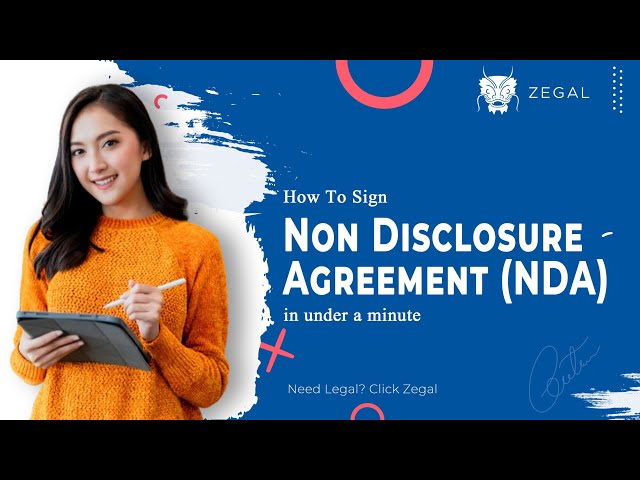How to generate a Non-Disclosure Agreement (NDA) for Africa
What is an NDA?
NDA stands for Non-Disclosure Agreement. It is also commonly known as a Confidentiality Agreement or a Confidential disclosure agreement.
Its purpose is to prevent unauthorised disclosure of sensitive information, such as trade secrets, business plans, or other proprietary information.
If a party needs to share confidential information with another party to evaluate a potential partnership, investment, or other business opportunities, an NDA will be needed.
By signing an NDA, the parties involved agree to keep the information confidential and not to use it for any unauthorised purpose.
Confidential information is usually sensitive, associated with something technical, commercial, or monetary value such as trade secrets.
What is a Confidentiality Agreement?
A Confidentiality Agreement is the UK term for a Non-Disclosure Agreement. They serve exactly the same purpose.
Types of Non Disclosure Agreement
There are several types of non-disclosure agreements (NDAs) that can be used to protect different types of confidential information.
Unilateral NDA: Also known as a one-way NDA, this is used when one party is disclosing confidential information to another party, but the second party is not sharing any confidential information in return.
Mutual NDA: Also known as a two-way NDA, it is a type of agreement used when both parties share confidential information. It is often used in business negotiations, where both parties want to protect their confidential information while gaining access to the other party’s confidential information.
Simple NDA: This is the basic and most common form of NDA, which has a simple and straightforward language. It’s mostly used by small businesses and individuals.
Employee NDA: This type of NDA is used to protect confidential information when an employee is hired or when an employee leaves a company. It protects the company’s confidential information and prevents employees from disclosing information to competitors.
Partner NDA: This type of NDA protects confidential information when two or more parties enter a partnership or other business relationship. This type of NDA is used to protect each party’s confidential information and prevent the unauthorised use or disclosure of confidential information by the other party.
When is NDA and when is it used?
NDAs are very popular in the corporate world to safely protect client information and keep company data and future goals private from the external environment.
Apart from this, non-disclosure agreements are also popularly used when hiring an employee, contractors, or consultants, selling businesses or seeking potential investors, and discussing the details of an invention or new idea.
What is the purpose of the NDA contract?
The purpose of an NDA is the heart of the agreement. You will be giving or receiving confidential information concerning a specific transaction, like a deal, sale, or investment. You must clarify that you will share sensitive data only for that purpose.
The main goal of a Non-Disclosure Agreement is to protect sensitive information and patent rights and to state what information is confidential to avoid future confusion.
Why is a Non Disclosure Agreement important?
NDAs are important as they can protect and safeguard your interests.
During negotiations, it can help build trust and act as proof or evidence of the recipient’s obligation. It is essential to allow you to control the way your confidential information is used and prevent the theft of intellectual property.
Exclusions from confidential information
Not everything can be classified as confidential information. Some exclusions clauses define what is not protected by the NDA.
This can include information that is already out in public, information that has been authorised for release by the disclosing party, information that the other party had before the NDA was signed, and information that was discovered or formed by the recipient on their own.
Common Non Disclosure Agreement clauses
The core of a Non-Disclosure Agreement is the obligations included in it. These should outline the duties of the receiving parties to the disclosing party.
The NDA will comprise multiple clauses, each covering a specific topic, which might include the following:
Non-Disclosure of Transaction: The receiving party agrees not to share details of the transaction being discussed or negotiated.
Non-Solicitation: In hiring, either party can prevent the other from soliciting employees or diverting business from the other party.
Non-compete: Signing parties agree not to enter direct business activities if it competes with the other party.
Non-Circumvention: In cases where the Disclosing Party shares essential business contacts, a non-circumvention clause helps ensure that the receiving party will not bypass the agreement and directly engage in business with the contacts.
The time period for confidentiality in Non-Disclosures: NDAs can be set in ‘perpetuity’, meaning they run effectively forever. It’s much more common to set an expiration date of either the period of the transaction (plus some time afterwards, for example, six months) or for a fixed term, for example, two years.
After this time, confidential information is destroyed, returned (less common in a digital world), or erased.
The definition of confidential information: This is naturally very important, and you must spend time getting this right. It may even be necessary to itemise specific data if it is very complex or if information needs to be shared but not in full.
A Non-Disclosure Agreement needs to be very specific about defining the confidential information.
What happens if you break a Non Disclosure Agreement?
A non-disclosure agreement (NDA) can be broken if either of the parties involved fails to uphold their end of the agreement, as it will be considered a “breach of contract.
The consequences of breaking an NDA can vary depending on the specific terms of the agreement and the laws of the jurisdiction in which the NDA was signed.
In general, the consequences of breaking an NDA may include:
Injunctions: A court may order the party that broke the NDA to stop disclosing confidential information or to take specific actions to prevent further disclosure.
Damages: The party that suffered harm as a result of the NDA being broken may be entitled to monetary damages. This can include compensation for any losses suffered as a result of the breach, as well as any profits that the breaching party made as a result of the disclosure of the confidential information.
Criminal penalties: In some jurisdictions, the unauthorised disclosure of confidential information may be a criminal offence.
Legal fees: The party that broke the NDA may be responsible for paying the other party’s legal fees.
It’s important to note that breaking an NDA can also have severe consequences for the reputation of the party that broke the agreement and can significantly impact their ability to do business in the future.
Further, if an NDA is part of another agreement, such as an employment contract, it can lead to the termination of the agreement or termination of employment too.
Breaking the terms of an NDA is a severe breach of your confidentiality obligations under the agreement.
NDAs are important legal agreements that parties sign to protect valuable IP and trade secrets. A breach is taken very seriously, and you must take all suitable steps to safeguard the information you receive and ensure your team does the same.
Zegal’s NDA template will help protect your sensitive data.
What situations or circumstances might make an NDA unenforceable?
Non-Disclosure Agreements are legally enforceable. However, the enforceability will vary according to jurisdiction.
Further, there are instances where a court may determine and declare that a non-disclosure agreement is unenforceable. A few situations and circumstances when this can happen are:
Use of restrictive and broad language: The NDA can be deemed unenforceable if it has a limited and well-defined scope or duration.
If the information is not confidential: If any information is public knowledge, an NDA might not uphold it.
The request is illegal: An NDA will not be valid if the agreement is used to bind someone to do something illegal.
How long does an NDA last?
NDAs have a defined term. However, the length of time that an NDA remains in effect can vary depending on the specific terms of the agreement.
They are usually in effect for the period of time during which the terms of the agreement bind the parties.
NDAs can have specific provisions that set a specific date on which the NDA will expire. For example, an NDA may have a term of three years, after which the agreement will no longer be in effect. However, NDAs can have a “perpetual” term, which means that the agreement will remain in effect indefinitely or until it is terminated by one of the parties.
Perpetual term NDAs are not common and generally used only in situations where confidential information is considered extremely valuable and will always be considered confidential. However, the length of the NDA should be reasonable and cannot be restrictive.
Can an NDA be customised?
Yes, NDAs (non-disclosure agreements) can be customised to meet the parties’ needs.
The terms and conditions of an NDA will always vary depending on the nature of the information being protected and the parties involved.
For example, an NDA between a software development company and a client will have slightly different terms than an NDA between two business partners. However, the core of it will mostly remain the same.
How do you make sure an NDA is legally binding
A complete, legally enforceable NDA will have the following features:
- Clear identification of the parties with names and addresses.
- Clear definition of what constitutes ‘confidential information’. What information is being protected and how it is being protected should be mentioned.
- Include a time period and specify the length of time that the NDA will be in effect.
- Include an exclusions clause as some information may be excluded from the NDA, such as information that is already in the public domain.
- Include a governing law clause. It should be defined which law governs the NDA in case of any legal disputes
- Include a remedy clause and specify the legal remedies that will be taken in case of a breach of the NDA.
- Obtain signatures from all parties.
What are some common misunderstandings about NDAs?
- You can use the same NDA for all purposes.
- NDAs have to be drafted according to the nature of the confidential information being protected and the parties involved.
- NDAs last forever.
- NDAs only offer protection as long as they are in effect. They have a specific time period which is usually defined in the agreement.
- NDAs protect all information.
- NDAs only protect confidential information, which is defined and agreed upon by the parties involved; which is why it is important to clearly define confidential information to ensure that it is adequately protected.
- Only big companies use NDAs.
- NDAs can be used by companies of any size and in any industry.
- NDAs cannot be shared with third parties.
- NDAs can be shared with third parties if it is agreed upon by the parties involved in the NDA.
How can an NDA be used to protect intellectual property?
NDA (non-disclosure agreement) can be used to protect intellectual property (IP) by preventing the unauthorised disclosure of confidential information related to the IP.
When used with other legal tools such as patents, trademarks, and copyrights, an NDA can help to safeguard a company’s IP assets.
- Patents: NDA can be used to protect the details of an invention that is covered by a pending patent application.
- Trademarks: It can be used to protect unregistered trademarks, such as trade names, by preventing unauthorised use of these marks by third parties.
- Copyrights: It can protect copyrighted works, such as software code, by preventing the unauthorised reproduction or distribution of these works by third parties.
An NDA can be used to protect IP, it is not a substitute for patents, trademarks, copyrights, or other legal protections.
An NDA can help to keep the IP confidential and protect it from unauthorised use and disclosure, but it cannot prevent others from independently creating similar IPs or prevent unauthorised use or infringement of already registered IP.
Are there any alternatives to an NDA?
The following are alternatives or have similar features to an NDA (non-disclosure agreement) that can be used to protect confidential information:
- Proprietary rights agreements (PRA): PRAs are commonly used in the software development industry to protect source code and other forms of IP.
- Non-circumvention agreements (NCA): NCAs are commonly used in the business-to-business context to protect trade secrets and other confidential information.
- Non-compete agreements (NCA): Non-compete agreements are used to prevent individuals from using confidential information to compete with their current or former employer. This type of agreement usually puts restrictions on an employee’s ability to work for a competitor after leaving their current employer.
- Employee IP Assignment Agreement: An Employee IP Assignment ensures that an employee’s inventions and intellectual property developed during employment are assigned to the employer.
It’s important to note that each of these alternatives comes with its own specific legal requirements and limitations.
What are the pros and cons of NDA?
Pros:
- Protection of confidential information: NDAs can be used to protect a wide range of confidential information, such as trade secrets, intellectual property, and business plans.
- Legal recourse: In the event of a breach, an NDA can provide legal recourse, such as the ability to seek injunctive relief or monetary damages.
- Deterrence: The existence of an NDA can deter potential breaches by making it clear that confidential information is protected and that legal action will be taken in the event of a breach.
- Flexibility: NDAs can be customised to suit the parties’ specific needs and can be used in a wide range of situations.
Cons:
- Differs according to jurisdiction. NDAs can get difficult to enforce, especially if the confidential information is widely known or if the parties are located in different jurisdictions.
- Limited protection: NDAs can only protect confidential information and cannot prevent others from independently creating similar information or prevent unauthorised use or infringement of already registered IP.
- Limited duration: NDAs have a specific time period and the protection lasts only as long as the NDA is in effect.
- Misunderstandings: If the NDA is not clearly written and understood by all parties, it can lead to misunderstandings and disputes.
50% off an NDA template with Zegal
Sign up now and create an NDA for half price.
Stay compliant with the Zegal template library
Zegal legal template are meticulously crafted with the precision of AI and the expertise of seasoned human lawyers, providing a unique blend of speed and reliability.
You can trust that Zegal agreements are legally sound and fully compliant with current regulations.
Whether you're a startup, SME, or a larger enterprise, Zegal contract management will automate and speed up your legal processes.
Using Zegal will reduce risk, save money, and improve efficiency. Let us take care of the paperwork so you can focus on running your business.
Don’t compromise on speed or compliance. Stay secure, compliant, and efficient with Zegal.







